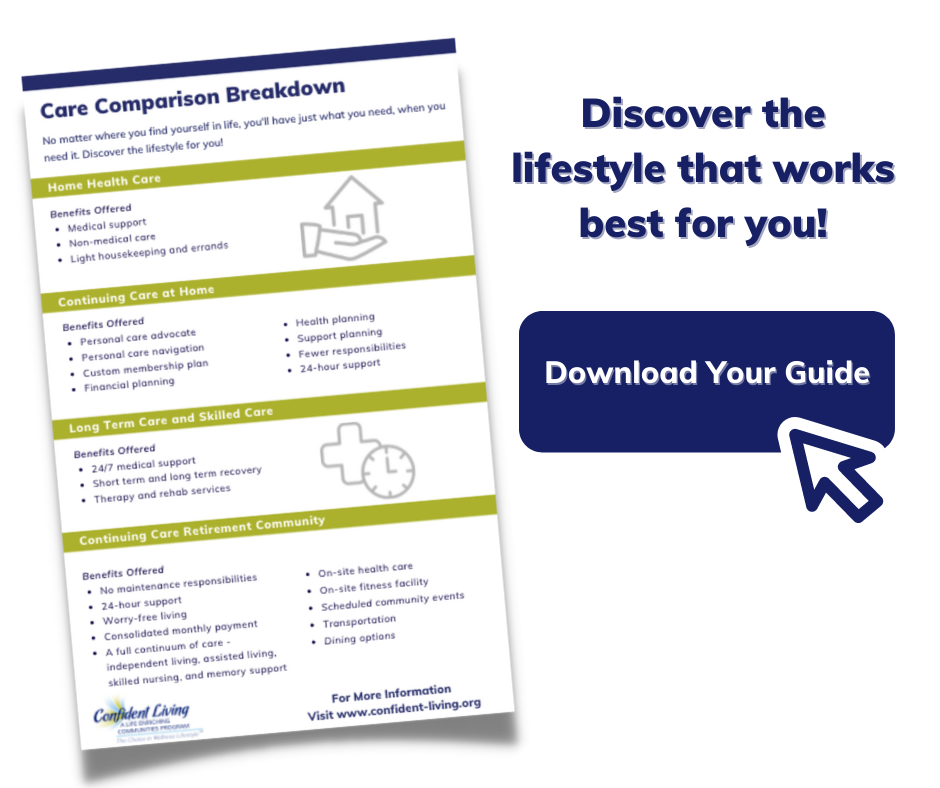
In this Guide:
- Introduction
- What is Continuing Care at Home
- The Components
- Membership
- Preplanning
- Is Continuing Care at Home Right For You?

Continuing Care at Home is a membership program that is designed to provide components of comprehensive assistance. This helps you balance your independence and health by receiving support and services in your home. People typically join the program while they are healthy and want to start planning for their future. This way they can get to know you while you are feeling good.
What is Aging in Place?
One alternative to a Continuing Care Retirement Community (CCRC) is a Continuing Care at Home Program (CCAH), which allows you to age in place. Aging in place means living at
home and having the support you need to age well and stress-free.
Aging In Place Data
By 2035 there will be more people over the age of 65 in the United States than under 18. This means there is a bigger incentive today to find solutions to many age-related challenges.
Here are some important numbers regarding those who are at retirement age:
• 80% of seniors want to age in their homes.
• 70% of seniors over 65 will experience an event requiring long-term care.
• According to the American Association of Retired Persons (AARP) there are approximately 45 million Americans aged 65 or older.
• A healthy 65-year-old couple retiring in 2019 will need close to $390,000 to cover health-care expenses, including Medicare Parts B and D, according to HealthView Services.
• Approximately 80% of older adults have at least one chronic disease, and 77% have at least two.
Taking these numbers into consideration highlights the importance of starting to plan today.

1. Care Coordination
When you become a member of the Confident Living Program, you gain access to a care coordination team. These are dedicated professionals that aid you 24/7. Their job is to help you in arranging and monitoring services, like appointments and transportation, so you can maintain an independent lifestyle in your own home.
The Care Coordinator lets you rest easy, knowing that your support system is already in place before you even need it. By an initial, personalized, assessment your care coordinator will familiarize themselves with your individual health and lifestyle preferences. It is this knowledge that enables them to support you should the need arise. This helps alleviate the concerns and emotional burdens from your friends and family.

2. Wellness Resources
With wellness resources, you can reach your goal to stay healthy and remain active. This includes making sure your home is aging-friendly. These resources help you with planning your ongoing support. It’s important to know that wellness isn’t just about physical fitness, it’s a way of life.
With the Living Well Program you can discover the 6 areas of wellness:
1. Emotional
2. Intellectual
3. Physical
4. Social
5. Spiritual
6. Vocational

3. Financial Planning
Confident Living is dedicated to your plan for retiring in your own home. This program works by providing additional safeguards to your personal savings no matter what surprises may come your way. This part of the plan is optional. This service works by paying an annual fee. This fee is determined during the customization of your plan and will depend on what you choose to include.
Your costs will depend on several factors:
• Age
• Health
• Plan Selection
Once approved, you will review options such as:
• Daily benefit for care services
• Length of term for care coverage
• Cost of living adjustment
• Discounts for household memberships
There are a variety of options when it comes to membership fees to Continuing Care at Home (CCAH). Some memberships resemble a Continuing Care Retirement Community with an upfront entrance fee, some don’t.
Here are some of the most common options:
• Entrance fee
• Monthly fee
• Annual fee
• Application Process*
* Application Process includes meeting the age requirement, submitting your application, receiving a health and wellness assessment, getting approved and customizing your plan.
Specifics You Should Know:
There are age requirements to Continuing Care at Home that may have different payment structures. Some have large up front fees while others, such as our own Confident Living assess an annual fee only, based on your customized plan options.
Preplanning for At Home Care
